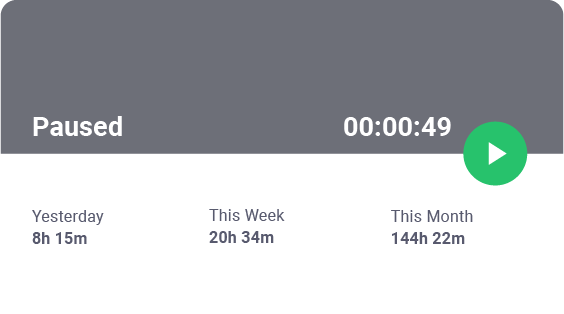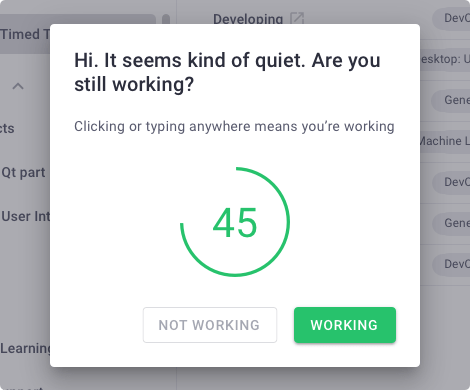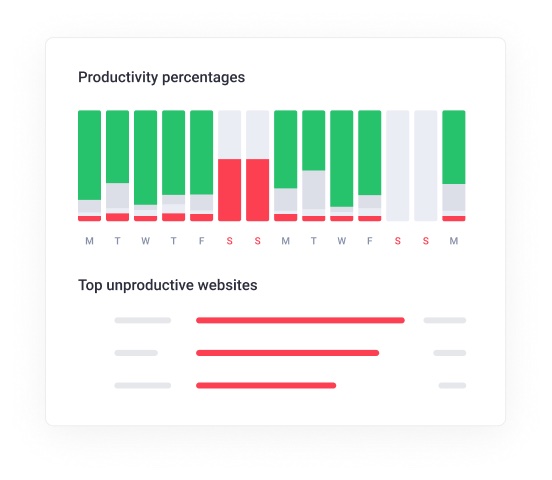The Coronavirus pandemic ushered in a cultural change within the workplace, specifically regarding productivity.
When a business adopts a culture of productivity, being productive becomes the driving force behind employees’ work ethic.
But what happens when productivity culture becomes toxic?
In this article, we’ll explore toxic productivity culture and its pitfalls. We’ll also cover what a healthy productivity culture looks like and its benefits.
Finally, we’ll share an excellent software tool to measure and boost your team’s productivity optimally.
Table of Contents
- What is a toxic productivity culture?
- 5 common pitfalls of a toxic productivity culture and how to avoid them
- What is a healthy productivity culture?
- 5 major benefits of having a positive culture within the workplace
- How Time Doctor can help build a healthy productivity culture
Let’s get started!
What is a toxic productivity culture?
Toxic productivity is a cultural trend driven by an obsession to stay productive at all costs without accounting for work life balance.
This goes hand in hand with hustle culture – a culture that has exploded due to social media. Individuals feel obligated to post about their busyness and compare it to their colleagues.
In a way, busyness has become a status symbol and something to brag about.
But what drives this trend?
The notion that a busy person is highly productive – a human capital attribute that’s considered a must to thrive in the modern job market.
How does it affect your business?
When toxic productivity culture seeps into a company, it could prove counterproductive.
Working long hours and not getting enough sleep makes employees less productive in the long run.
It could lead to frequent burnout, absenteeism, and other adverse effects.
Let’s explore these in detail.
5 common pitfalls of a toxic productivity culture and how to avoid them
When corporate culture places more value on increased productivity over a positive work environment, it may result in:
1. Decreased work quality
Toxic productivity may compel employees to work an extra hour or two to complete their workload.
It may also push them to work long hours into the night, affecting their sleep.
With their sole focus on achieving their targets, they may compromise on the quality of work.
Moreover, they may fail to recognize the hard work they’ve already done.
So, how can you minimize this risk?
Managers must encourage employees to set work limits while determining SMART (Specific, Measurable, Attainable, Relevant, and Time-based) goals for themselves.
They should also emphasize the importance of task prioritization so that employees don’t spend their peak hours on trivial tasks.
2. Decreased employee engagement
Employee engagement is a fundamental building block of an organization’s success. Employees feel respected, secure, supported, and valued when appropriately engaged.
So, it’s no surprise that decreased employee engagement comes at a cost for employers.
Harvard Business Review reports that organizations with low employee engagement have an 18% lower productivity rate, 16% lower profitability, and 37% lower job growth than those with better engagement.
With these statistics in mind, here are a few things to consider when implementing an employee engagement program:
- Empower employees with the tools needed to excel in their positions.
- Organize team-building events to aid meaningful connections between employees.
- Schedule weekly meetings with employees to understand their goals.
3. Lower employee morale
Toxic productivity places utmost importance only on productivity, often without accounting for an employee’s hard work and dedication. This can lead to lower employee morale within the workplace.
When low employee morale strikes, it can manifest in several ways. Besides affecting productivity, it may lead to increased stress and absenteeism.
Although such employees may meet their deadlines, they’ll lack the required motivation for their job, leading to inefficiencies.
What’s worse?
Low employee morale is contagious. So employers must keep their finger on their team’s pulse and take proactive measures to keep employee morale high.
Here are some pointers to boost employee morale:
- Place greater importance on employees’ health and wellbeing while providing the necessary support.
- Offer employees autonomy to make decisions where possible.
- Adopt an employee-centered approach that places less emphasis on productivity as the goal.
4. De-prioritizing self-care
Toxic productivity culture can lead to overworking among employees.
Employees risk their mental health by valuing productivity and the expectation of others over their well-being.
It may lead to longer workdays, increased stress, and feeling burned out.
So how can you prevent job burnout?
A business owner can consider the following tips:
- Encourage employees to take time off to spend with loved ones.
- Offer health and wellness days with in-house massages.
- Invest in mental health awareness campaigns.
5. Higher employee attrition
Employees who experience high levels of stress and no time for their personal life may be more inclined to resign and hit the job market.
To prevent this, you must constantly check in with your employees and address their grievances. This will lead to higher job satisfaction and minimize the risk of attrition.
Now that you understand the pitfalls of toxic productivity, let’s explore what an ideal productivity culture looks like.
What is a healthy productivity culture?
Studies emphasize that a positive work environment benefits both employers and employees by contributing to healthy company culture.
It encompasses the company’s objectives and acts as a guiding light for employees. Most importantly, it aligns with a positive employee experience.
Here are some characteristics of positive and productive workplace culture:
- Promotes an atmosphere of self-improvement.
- Lays a strong focus on teamwork and collaboration to achieve targets.
- Fosters an environment of incremental learning and productivity improvement.
- Encourages a healthy work-life balance.
With these attributes in mind, let’s take a closer look at the positive impact productive workplace cultures can inspire.
5 major benefits of having a positive culture within the workplace
The following benefits show the impact of having a positive culture in your organization:
1. Higher company productivity
Unsurprisingly, research shows that company culture and productivity are linked.
The Alternative Board reports that 86% of employees believe workplace culture directly impacts productivity.
Consider a scenario where an employee is being less productive than usual.
In this case, positive company culture will ensure that their team leader and coworkers encourage them instead of blaming them. They will also be willing to identify and address the root cause behind these unproductive patterns.
2. Increases employee engagement
How does a positive culture boost employee engagement?
A positive work culture embodies transparency, has clear expectations, offers recognition, and values continuous feedback.
This fosters an environment of collaboration and efficiency among employees.
And when employee engagement is high, employees show care and respect for their work duties and the company.
A positive culture within the workplace can lead to better job satisfaction as it encourages a positive employee experience.
3. Boosts employee commitment
Positive company culture can strengthen an employee’s commitment to the organization.
Employees’ commitment largely results from their overall experience with their colleagues, team leader, and higher management.
In your personal life, you wouldn’t show commitment to someone who doesn’t share your best interests at heart. Similarly, in a work environment, employees will be committed to an organization that cares for them.
Overall, a harmonious culture has a positive impact on employee commitment and can keep attrition rates in check.
4. Improves employee retention
Today, employees want to feel part of a work environment where they feel valued. An organizational culture that promotes this can help businesses retain skilled employees.
Hiring talented individuals is the easy part, but retaining these employees can prove to be difficult.
A work culture that empowers employees, celebrates successes, promotes inclusion, and prioritizes meaningful connections can go a long way in encouraging employee loyalty.
Learn more about 7 Practical Strategies to Improve Employee Retention.
5. Enhances collaboration between employees
Collaboration drives innovation and teamwork. Studies show that about 75% of employees view collaboration as necessary.
A positive company culture encourages harmonious collaboration among workers and individuals.
For example, new hires may feel anxious about collaborating with existing employees when they join the team. With a cohesive work culture, existing employees foster an environment where new employees feel comfortable.
This ensures that employees feel part of a team, fuelling their desire to stay actively involved within the organization.
While it’s mostly up to employees and their mindsets to ensure a positive culture, productivity can also be encouraged by the right set of empowering tools.
How Time Doctor can help build a healthy productivity culture
It is no secret that technology solutions can help business leaders build a workplace culture that focuses on healthy productivity.
With many employee productivity monitoring tools available today, which one should you invest in?
The answer is simple: Time Doctor.

Time Doctor is an employee productivity management and time tracking software trusted by large companies like RE/MAX, smaller enterprises like Thrive Market, as well as freelancers.
Its time tracking feature is a perfect tool to understand how productively your team spends their work hours.
Let’s take a look at some of the key features Time Doctor offers:
A. Transparent time tracking
Time Doctor offers an easy-to-use time tracker with two convenient modes, manual and automatic. The manual mode allows employees to track their work hours using a simple start/stop timer.
To use the interactive mode, follow these steps:
- Download the Time Doctor desktop app.
- Create an entry for a specific task.
- Press the start button to begin time tracking.

- To end time tracking on a task or to take a break, press Stop.

The automatic tracking mode initiates as soon as the computer turns on. It runs in the background without interrupting an employee’s workflow.
B. Idle time alerts
On top of tracking hours worked, Time Doctor also tracks employees’ idle time – the time when they don’t use the keypad or mouse.
Admins can set idle time limits. Once the limit has expired, a notification will pop-up reminding employees to continue working or take a break.

Note: Time Doctor isn’t a keylogger. It only checks for key presses and mouse clicks to determine if the user is working actively.
C. Productivity ratings
Time Doctor also allows you to categorize apps and websites based on how relevant they are to employees during their workday.
It lets you assign each app and website a productivity rating:
- Productive.
- Neutral
- Unproductive
- Unrated
For example, if your marketing employee uses Twitter to run an advertising campaign, you can classify the website as productive.
This feature lets employers see how productive an employee was during their workday, depending on the websites and apps used.

D. Detailed productivity reports
Reports are a great way to monitor unproductive patterns and identify overworking issues at the earliest.
Time Doctor produces a variety of productivity reports, like:
- Attendance Reports: Track when an employee was present, late, or absent.
- Activity Reports: See how employees spend their time; active, idle, or unproductive.
- Timeline Reports: Receive a visual timeline of every employee’s workday.
- Hours Report: Monitor how many hours an employee clocked in a day or selected period.
- Web and App Usage Reports: Access which apps and web pages employees visited while on the clock.
- Projects and Tasks Report: See the time spent on specific projects and tasks.

E. Work life balance insights for employees
Time Doctor now offers a work-life balance widget that lets you spot signs of burnout and work-life balance issues among employees.
It’s an effective way to minimize the risk of toxic productivity culture creeping into your workplace.
By promoting a healthy work life balance, employees can enjoy higher levels of engagement and performance.
The real-time dashboard offers insights on the following:
- When employees work too many hours per day.
- When they work too many late hours.
- When they work outside of their shift.
- When they work on weekends.

That’s a wrap!
Productivity is the driving force behind the success of a business. But much like anything in life, too much of a good thing can lead to adverse outcomes.
The same goes for productivity. If your work culture values productivity over quality and an employee’s self-worth, you may risk toxic productivity hampering your growth.
Use this article to assess your approach to workplace productivity and how to positively boost it.
What can help you in the process is an incredible tool like Time Doctor, which helps you build a highly productive workforce while ensuring a healthy work life balance.
So why not sign up for Time Doctor’s free trial and discover for yourself how it can benefit your business?

Vaishali Badgujar is a seasoned Content and SEO specialist who provides ROI-focused managed SEO services. She is dedicated to helping businesses connect with their audience online and see real growth through her work.


